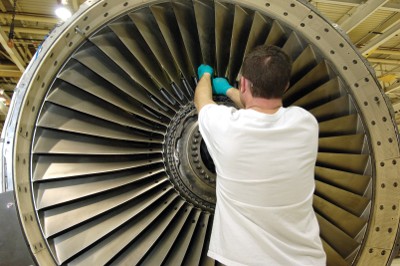 |
| March 06, 2012 | Volume 08 Issue 09 |
Designfax weekly eMagazine
Archives
Partners
Manufacturing Center
Product Spotlight
Modern Applications News
Metalworking Ideas For
Today's Job Shops
Tooling and Production
Strategies for large
metalworking plants
Switching to used fan blades saves Air Force tens of millions

Richard Rook, a jet engine mechanic with the 546th Propulsion Maintenance Squadron, inserts a fan blade into an overhauled F108 fan frame major module. Tinker AFB recently purchased 1,036 sets of used fan blades rather than new ones for F108 engines, saving the Air Force more than $36 million. More of the fan blades are scheduled to be purchased over the next two years; estimated cost avoidance is another $34 million. [Image: U.S. Air Force]
A Value Stream Analysis of the Source Approval Request process has paid big dividends to the Air Force.
The VSA was led by Melanie Jonason, chief engineer in the Propulsion Sustainment Division at the Oklahoma City Air Logistics Center and championed by Col. Steve Bleymaier.
This cross-functional team – including small business, contracting (both Air Force and Defense Logistics Agency), propulsion engineers, and Global Logistics Support Center supply chain managers – analyzed the long-standing Source Approval Request process, identified needed improvements, and built the process to purchase commercial used parts.
The analysis verified the potential for substituting used fan blades instead of costlier new ones in F108 jet engines.
The F108 turbofan engine is used in KC-135 Stratotankers, E-3 Sentrys, and E-6 Mercurys, all of which are stationed at Tinker.
"I did master's degree work at Oklahoma State University on the source approval process," Jonason recalled. "I finally got my chance to prove its worth" on a contract awarded recently for the acquisition of 1,036 sets of fan blades for the F108 engines.
One supplier bid new parts, at a cost of $43.79 million. Four other companies bid used parts. The winning bid, from AerSale's regional office in Grapevine, TX, came in at $7.1 million – a savings of more than $36 million, or 84%. The unit price is $6,855 per pair of used titanium fan blades, versus a price tag of $42,273 for a pair of new fan blades.
"We have more fan blades to buy over the next two years," so the anticipated cost avoidance on those purchases is another $34 million, Jonason added.
That's $70 million in savings on just one part.
The key to the substitution concept is the availability of CFM56 jet engines. The military F108 engine is a variant of the CFM56 commercial jet engine. CFM56s have become available with the retirement of many commercial jets, Jonason said. "FedEx retired their whole fleet, and others are doing the same."
Jonason, who has worked at Tinker for 10 years, indicated other factors also contributed to the decision to substitute used parts for new ones in the F108:
- The repair source for the blades is the same for both the commercial and the military markets, and has already received the Air Force seal of approval.
- There is limited liability risk because the blades can be changed without removing the engine from the aircraft or opening the cases.
- The fan blades are durable. On average, CFM56 engines clock four times as many flight hours as the F108. Nevertheless, the failure rate of the blades has been only 3% to 5%. The used fan blades are sent to a California company, which inspects them for abrasions, chips, wear, or other defects; refurbishes the blades when necessary; then ships them to Tinker.
"From an engineering perspective, the risk of buying used fan blades was assessed and found to be minimal," Jonason said.
Since the savings from the fan blades was so dramatic, "We're evaluating what other parts might be suitable for substitution," she continued.
Preliminary studies estimate the potential savings from using "recycled" fan blades, booster vane assemblies, and other "prototype" parts on the F108 engine in fiscal years 2012-14 could be as much as $146 million.
"And then we want to take a look at other Air Force engines that have commercial equivalents," Jonason said.
Published March 2012
Rate this article
View our terms of use and privacy policy
